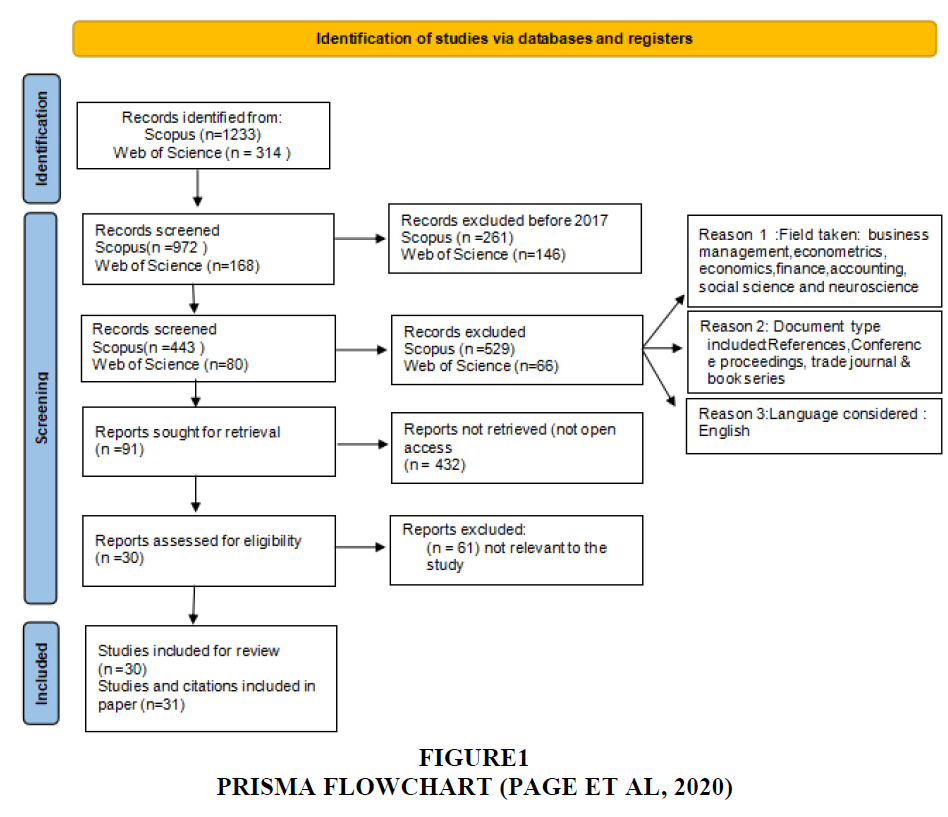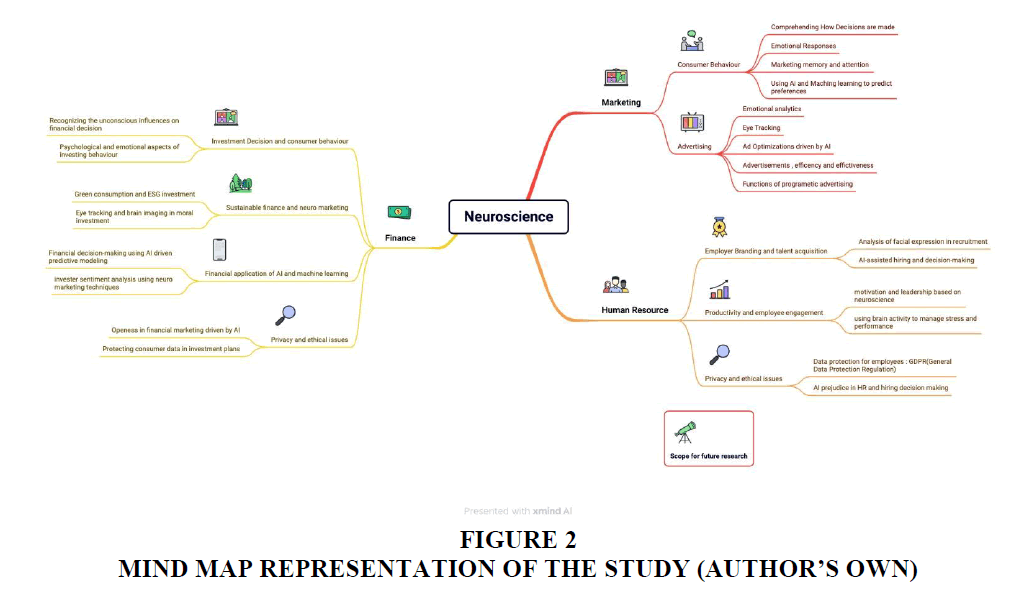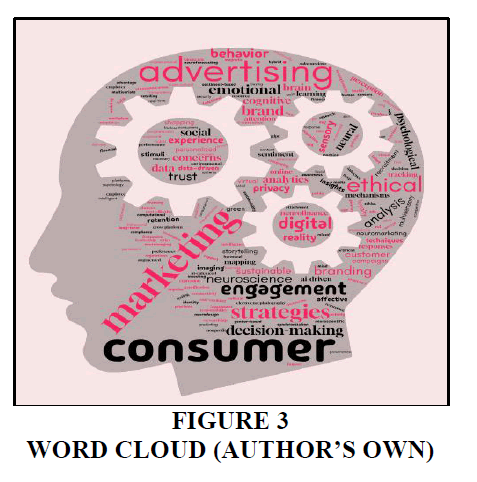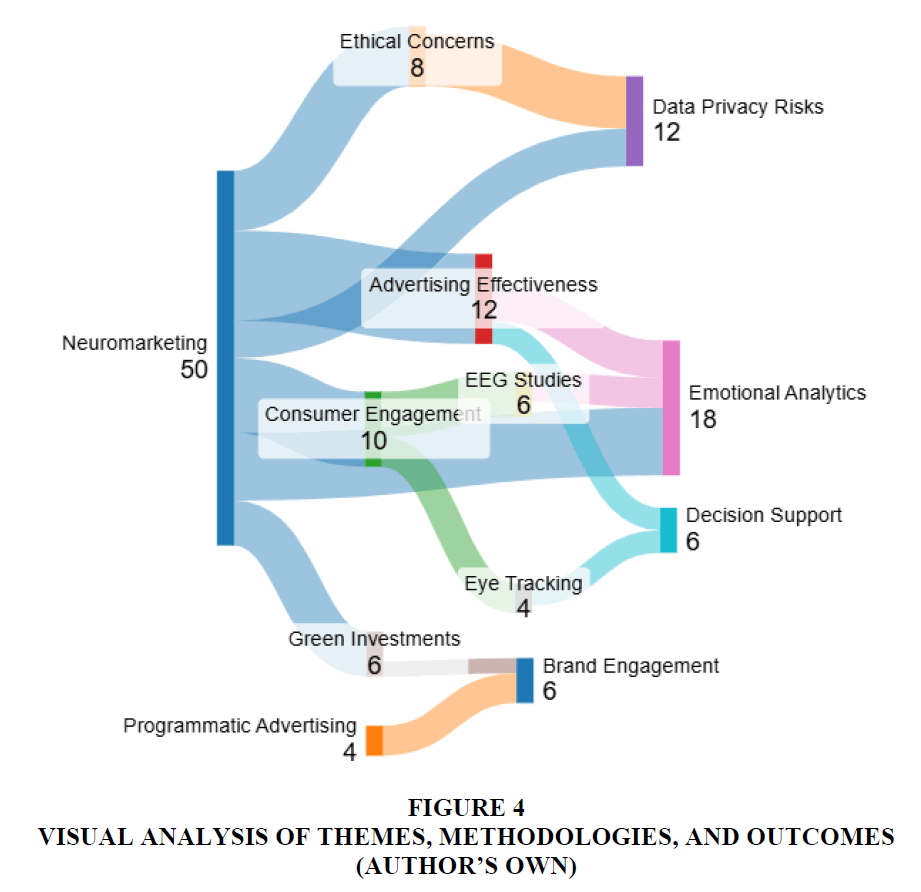Research Article: 2025 Vol: 29 Issue: 5S
From Brain to Business: The Role of Neuroscience in Marketing, HR, and Finance along with Ethical Issues
Kriti Arya, Management Development Institute
Vandana Bhardwaj, SDGI Global University
Vandana Kumari, Banasthali Vidyapith, Rajasthan
Divya Singh, KR Mangalam University, Gurgaon
Citation Information: Arya, K., & Bhardwaj, V., Kumari, V., & Singh, D. (2025). From brain to business: the role of neuroscience in marketing, hr, and finance along with ethical issues. Academy of Marketing Studies Journal, 29(S5), 1-20.
Abstract
The study intends to investigate the ever-evolving field of neuroscience and address ethical issues like privacy and manipulation, emphasizing its applications in consumer behavior analysis, advertising techniques, sustainable finance, and organizational practices. Research articles from the Wiley Online Library and Scopus databases were chosen for a systematic literature review that was carried out utilizing the PRISMA methodology. Mind map and Heat Map Analysis are used to analyse the study from different perspectives. By matching marketing to consumer values, neuromarketing greatly improves knowledge of customer preferences, advertising effectiveness, and sustainable financing practices. Emotional analytics and brain imaging are two methods that enhance advertising efforts and encourage moral investment. However, appropriate and transparent use is required due to ethical concerns about data privacy. In conclusion, the combination of marketing and neuroscience offers a profound understanding of consumer decision-making, improving marketing accuracy and supporting sustainable finance projects. The development and acceptance of the field depend on addressing ethical issues.
Keywords
Neuroscience, Neuromarketing, Neurofinance, Human Resource, Ethical Challenges, Mindmap, Heat Map Analysis.
Introduction
Neuroscience has evolved over the last 20 years from an academic theory to a useful instrument for enhancing business marketing plans. The term "neuromarketing," which was first used in the early 2000s, expands on previous studies on consumer psychology (Mehta, 2024). To better understand customer behavior and improve marketing accuracy, neuromarketing makes use of neuroscience tools such as fMRI and EEG (Sourov et.al.,2023). Although it provides valuable information for tailored approaches, it brings up moral questions of manipulation and mental privacy. Its responsible application requires an ethical mindset. (Goncalves et.al., 2024). Sustainable finance can be revolutionized by neuroscience, which uses AI and neuroimaging to reveal hidden investment and consumer motivations and promote morally sound, emotionally compelling solutions. However, because of privacy and manipulation concerns, accountable and transparent methods are necessary to guarantee autonomy, sustainability, and ethical integrity (Ahirwar & Singh 2025). It examines the brain mechanisms underlying consumer preferences, talks about its techniques and uses, raises moral questions, and projects its commercial future (Singh, et al. 2025). Businesses and academics throughout the world are becoming more interested in neuromarketing, which combines marketing and neuroscience. Both developed and developing nations are contributing to this field of study (Kajla et al. 2024).
Review of Literature
The review of literature is based on descriptive semi-thematic analysis, which is represented in a Matrix structure. The papers were selected based on the PRISMA (Preferred Reporting Items for Systematic Reviews and Meta-Analyses) framework shown in the study:
Research Objectives
The following are the objectives of the study:
1) Examine how customer behavior, marketing tactics, and decision-making are affected by neuromarketing tools (eye tracking, brain imaging, emotional analytics).
2) Study how neuroscience, through cognitive and emotional insights, might improve HRM procedures including hiring, employee engagement, and leadership development.
3) Investigate how neurofinance might be used to encourage sustainable investing by addressing ethical issues with data privacy and transparency and matching financial products with customer values.
Research Methodology
The study is based on systematic literature review of research papers, chapters, and articles. The literature is selected using PRISMA technique (Page et al. 2020). Two databases are used to select relevant papers, ie., from Wiley online library and Scopus Figures 1 & 2.
Two different databases were used to extract papers for the review: Scopus database and Web of Science(WoS). A total of 1547 papers were found. The data was searched using boolean as “Neurscience*” AND “Marketing” OR “Neuromarketing” AND “Human Resource Management” OR “HR” AND “Finance*”. Papers were selected on the basis of field” business manegement,econometrics,economics,finance,accounting,social science and neuroscience. All types of research papers including book series, conference proceedings and trade journals were included. Papers in English language were selected. Some of the papers were not retrievable. After applying these filters, a total of 91 papers were left for assessment. In these papers, 61 papers were found to be irrelevant for the study. So, finally 30 papers were included for the reviewing and one paper/citation was used for PRISMA framework.
Findings
Neuroscience in Marketing: “Neuromarketing”
The application of brain research, such as eye tracking, in neuromarketing, helps to forecast customer behavior and enhance advertising (Bajaj, et al. 2024; Siddique, Shamim, and Abid, 2023). The advancement of neuromarketing through neuroscience and psychophysiology for improved customer understanding is the main topic of Casado et al. (2023). Its function in assessing brain activity to efficiently satisfy client wants is confirmed by Ismajli, Ziberi, and Metushi (2022).
Neuromarketing & Consumer Behaviour
Neuromarketing determines the demands and preferences of customers. It examines how the brain works and how consumers perceive products when making judgments (Ismajli et.al.,2022). Neuromarketing helps in analyzing brain signals to refine marketing strategies and consumer insights (Kajla et al.,2024). Neuro-forecasting is a method that helps to concentrate on predicting the overall preferences and motivational structure of the clientele (Yao & Wang, 2024). Consumer decision-making varies based on brain responses to advertisements (Clithero et al.,2024). Neuromarketing identifies consumer needs by analyzing brain activity and product perception (Ismajli, Ziberi & Metushi,2022). The gaze patterns, fixation counts, and emotional reactions are studied for online ads. These factors influence purchasing decisions and consumer preferences (Clithero et al.,2024). By analyzing images and videos and combining facial expression and eye tracking to improve emotion recognition, neuromarketing techniques (eg. Fnris) help marketers make better decisions and plan their marketing strategies (Gill & Singh, 2022). Through content personalization, enhanced emotional engagement, and the use of gamification, narrative, and interactive graphics to increase brand connection, memory recall, and loyalty, artificial intelligence (AI) and digital experiences influence the relationship between neuromarketing and consumer behavior (Umashankar & Charitra,2024)
Neuromarketing in Concern with Advertisement
Neuromarketing enhances programmatic advertising by analyzing consumer responses to understand preferences and influence decision-making (Bajaj, Ali & Singh, 2024). Ad effectiveness is shaped by important elements that affect consumers' mental health, including emotions, perception, motivation, memory, and attention (Alsharif et al., 2024). By evaluating attention, engagement, delight, and disgust, methods such as Electrodermal Activity (EDA) and Facial Expression Analysis (FEA) can predict consumer ad choices with 81% accuracy (Marques et al., 2025). Nonprofit advertisements gain from emotional and cognitive engagement, whereas celebrity, jingle, and humor advertisements increase remember and buy intent (Martinez et al., 2022; Adalarasu et al., 2025). Incorporating neuromarketing into contemporary marketing requires a reasonably priced neurometric framework (Gill & Singh, 2022). Because smokers' distinct EEG patterns make them less receptive to anti-smoking advertisements, customized neuroimaging-based advertisements are essential (Ghods et al., 2024). While AI, VR, and neuroscience enhance ad targeting by resolving data usage and transparency concerns (Zámečník, 2024; Hsu et al., 2023), neuromarketing's varied techniques and ethical challenges continue to change marketing research (Lim, 2018).
Neuroscience in Organizations (Human Resource Management): “Organisational Neuroscience/Neuro-HR”
Businesses can better understand consumer preferences and increase satisfaction by utilizing neuroscience (Ismajli, Ziberi & Metushi, 2022). Addressing ethical issues and examining consumer behavior, emotions, and product positioning, improves corporate strategies (Bhardwaj et al.,2024). Neuromarketing's promise for real-time consumer insights and strategic decision-making is supported by the great accuracy with which EEG data has been utilized to predict product preferences (Alnuman et al., 2024). With an emphasis on ethical sustainability, Festa et al. (2022) emphasized the rise of neuroscience in healthcare, which is being propelled by digital marketing and non-invasive techniques like eye tracking. While AI-generated material improves health messaging through attention and emotional engagement, highlighting gender-sensitive techniques, EEG signals are analyzed to differentiate cognitive and affective reactions in healthcare fundraising (Balafas et al., 2024).
While AI-generated material improves health messaging through attention and emotional engagement, highlighting gender-sensitive techniques (Lyulyov et al.,2024), EEG signals are analyzed to differentiate cognitive and affective reactions in healthcare fundraising (Balafas et al., 2024). By combining neuromarketing and big data analytics, hybrid approaches can be used to enhance organizational performance and website interfaces (Giannakopoulos et al., 2024). Deeper consumer insights can be obtained by combining conventional and neuroscience-based approaches (Hsu et al., 2023). To advance neuroscience in organizations and improve competitive advantage, corporate value, and customer loyalty, strong leadership support is necessary (Chatterjee et al. 2023). Facial expression analysis is one way that neuroscience plays a big part in talent acquisition (Kaklauskas et al., 2022). As a result, it influences employer branding and enhances hiring practices (Koohang et al., 2023). Organizational Cognitive Neuroscience (OCN) was presented by Braeutigam et al. (2019) as a promising field for researching behavior, leadership, and decision-making in the workplace. MEG is driving research improvements in OCN while highlighting ethical considerations for responsible implementation.
Neuroscience and Finance: “Neurofinance”
Consumer neuropsychology, neuromarketing, and ethical finance shape sustainable investing (Ahirwar & Singh, 2025). Techniques like eye tracking, fMRI, and EEG reveal that ethically branded products activate reward-related brain regions, linking sustainability to personal fulfillment. These insights help financial firms create investment products that align with consumers' unconscious values and ESG criteria.
Through the use of brain research to sway consumer decisions, the promotion of green investment techniques, and the strengthening of corporate environmental responsibility, neuromarketing and sustainable finance combine to encourage environmentally conscious investments(Kundra & Hussain,2025; Balaji, 2025).
The Sankey diagram graphically illustrates the complex connections between the main research topics, approaches, and findings found in the literature on consumer behavior and neuromarketing. The above diagram is made through SankyMATIC. Each flow line's width provides information about the prominence of particular linkages by indicating the frequency and strength of connections between nodes. The focus is on "Neuromarketing," which has a close connection to important subjects like "Ethical Concerns," "Consumer Engagement," and "Advertising Effectiveness." These links demonstrate the field's twin emphasis on utilizing neuroscience to improve marketing tactics and resolve moral dilemmas. The transitions between "Ethical Concerns" and "Data Privacy Risks" highlight the continuous discussion about privacy and the moral ramifications of neuromarketing techniques. The connections between "Consumer Engagement" and cutting-edge methods like "Eye Tracking" and "EEG Studies" highlight how important they are for comprehending unspoken customer reactions. Similarly, the correlations between "Emotional Analytics" and "Advertising Effectiveness" suggest that using emotional insights to create compelling marketing efforts is becoming more and more common. Notably, weaker correlations, like those about "Green Investments" and "Brand Engagement," point to new directions that need investigation, especially when it comes to fusing sustainability with neuromarketing techniques. As a result, this graphic facilitates the mapping of current research contributions and the identification of possible research gaps.
Discussion
Neuromarketing offers insights into customer behavior by exposing unconscious decision-making processes through the use of cutting-edge brain research techniques including EEG, eye tracking, and skin response. It improves marketing tactics by examining emotional, attentional, and memory reactions, especially in online shopping and advertising. AI and digital experiences combined with neuromarketing produce individualized and emotionally compelling advertising. Green investments and ethical goods are also encouraged by their use in sustainable finance. To strengthen customer relationships for organizations, future developments in neuromarketing will rely on additional empirical research, technological breakthroughs, and ethical considerations.
On a scale of 1 to 5, the heat map rates the important elements impacting a system or technology in three areas: Benefits, Challenges, and Opportunities. Although moderate obstacles (4) indicate some implementation barriers, Technology Adoption ranks highly in both Benefits (5) and Opportunities (5), showing its great present and future influence. The need for more improvements is highlighted by the fact that User Experience & Engagement face significant obstacles (3) but also exhibit moderate benefits (4) and future potential (4). The complexity of managing data properly is shown by the fact that Data Management poses substantial obstacles (5), even in the face of substantial advantages (4) and promising prospects (5). While moderate limitations (4) point to technical obstacles, Scalability & Performance reflects Technology Adoption with high advantages (5) and future potential (5). Finally, the greatest difficulty (5) is presented by Ethical & Regulatory Concerns, which also show moderate advantages (3) and future scope (4), suggesting the necessity for regulatory developments. For strategic decision-making, this heat map offers an organized summary of the company's advantages, disadvantages, and potential growth regions.
To better understand customer behavior and emotional involvement, future neuromarketing research will also make use of cutting-edge neuroscientific technology such as fMRI, EEG, and eye tracking. Cultural disparities, gender-based marketing, and ethical consumerism are important research topics. Through OCN, insights into employee dynamics and leadership may be useful for organizational policies. Personalized marketing is made possible by the incorporation of AI-driven analytics, which also improves practicality. Furthermore, researching neuromarketing's application in social media and digital marketing as well as moral issues like trust and privacy will be essential to its advancement.
Conclusion
The integration of neuroscience into marketing, human resource management, and finance offers transformative potential for businesses. Deep insights into customer behavior are provided by neuromarketing methods such as EEG, eye tracking, and emotional analytics, which improve advertising strategies by creating emotionally compelling and customized campaigns. By examining cognitive and emotional reactions, enhancing recruitment tactics, and creating a good work atmosphere, neuroscience in human resource management supports talent acquisition, employee engagement, and leadership development. Neurofinance is a branch of finance that uses brain science to support sustainable investments by matching financial goods to users' ESG standards and ethical beliefs. Neuroscience has a bright future in marketing, human resources, and finance. AI and cutting-edge neuroimaging can be combined in marketing research to provide real-time customer insights, cross-cultural research, and tailored advertising. Organizational cognitive neuroscience can help HR with digital recruitment, employee well-being, and leadership. Opportunities to research ethical finance, AI-driven financial products, and brain-based investment behavior are presented by neurofinance. For these industries to flourish sustainably, ethical issues like data privacy and legal frameworks will be major areas of concern.
References
Adalarasu, K., Begum, K. G., Priyan, M. V., Devendranath, C., & Sriram, G. V. (2025). Neuro-signaling techniques in advertisement endorsements: Unveiling consumer responses and behavioral trends. Journal of Retailing and Consumer Services, 84, 104175
Indexed at, Google Scholar, Cross Ref
Ahirwar, S., & Singh, M. (2025). Neurofinance Revolution: Emerging Technologies and Future Trends at the Intersection of Neuromarketing and Sustainable Finance. Neuromarketing's Role in Sustainable Finance, 205-230.
Alnuman, N., Al-Nasser, S., & Yasin, O. (2024). Comparing Different Classifiers and Features for Electroencephalography-Based Product Preference Recognition. International Journal of Fuzzy Logic and Intelligent Systems, 24(3), 258-270.
Alsharif, A. H., Salleh, N. Z. M., Baharun, R., Hashem E, A. R., Mansor, A. A., Ali, J., & Abbas, A. F. (2021). Neuroimaging techniques in advertising research: Main applications, development, and brain regions and processes. Sustainability, 13(11), 6488.
Indexed at, Google Scholar, Cross Ref
Bajaj, R., Ali Syed, A., & Singh, S. (2024). Analysing applications of neuromarketing in efficacy of programmatic advertising. Journal of Consumer Behaviour, 23(2), 939-958.
Balaji, K. (2025). Neuromarketing and Sustainable Finance: Real-World Case Studies of Green Investment Promotions. In Neuromarketing's Role in Sustainable Finance (pp. 169-204). IGI Global.
Bhardwaj, S., Jain, V., Mahapatra, D., & Sindhwani, R. (2024). Exploring the Dark Side of AI and Its Influence on Consumer Emotion. Journal of Consumer Behaviour.
Braeutigam, S., Lee, N., & Senior, C. (2019). Organizational Cognitive Neuroscience: A New Frontier for Magnetoencephalography. Magnetoencephalography: From Signals to Dynamic Cortical Networks, 1209-1225.
Casado‐Aranda, L. A., Sánchez‐Fernández, J., Bigne, E., & Smidts, A. (2023). The application of neuromarketing tools in communication research: A comprehensive review of trends. Psychology & Marketing, 40(9), 1737-1756.
Indexed at, Google Scholar, Cross Ref
Chatterjee, S., Chaudhuri, R., & Vrontis, D. (2023). Value based marketing: Examining the role of leadership support in promoting neuromarketing. Journal of Transnational Management, 28(1–2), 141–164.
Indexed at, Google Scholar, Cross Ref
Chaurasia, M., Kumar, A., & Panda, R. K. (2024). Two decades of research on “masstige” marketing: A systematic literature review and future research agenda. International Journal of Consumer Studies, 48(5), e13077.
Clithero, J. A., Karmarkar, U. R., Nave, G., & Plassmann, H. (2024). Reconsidering the path for neural and physiological methods in consumer psychology. Journal of Consumer Psychology, 34(1), 196-213.
Festa, G., Pjero, E., & Feoli, S. (2022). The social impact of clinical tools for neuromarketing research: Possible applications for the wine sector. In Business Advancement through Technology Volume I: Markets and Marketing in Transition (pp. 117-136). Cham: Springer International Publishing.
Ghods, H., Aghayari, M., Golbazi Mahdipour, A., Arabi Zanjani, R., Aghayari, H., Soparnot, R., & Bonyadi Naeini, A. (2024). Maximizing the Effectiveness of Anti-Smoking Campaigns With Targeted Framing Strategies: Evidence From Behavioral and Neurological Studies. Social Marketing Quarterly, 15245004241260639.
Hsu, L. R., & van der Hof, S. (2023). Fostering Inclusivity for Children with Intellectual Disabilities through Data Protection by Design. European Journal of Law and Technology, 14(3), 1-29.
Ismajli, A., Ziberi, B., & Metushi, A. (2022). The impact of neuromarketing on consumer behaviour. Corporate Governance and Organizational Behavior Review, 6(2), 95-103.
Kajla, T., Raj, S., Kansra, P., Gupta, S.L., & Singh, N. (2024). Neuromarketing and consumer behavior: A bibliometric analysis. Journal of Consumer Behaviour, 23(2), 959-975.
Indexed at, Google Scholar, Cross Ref
Kaklauskas, A., Abraham, A., Ubarte, I., Kliukas, R., Luksaite, V., Binkyte-Veliene, A., ... & Kaklauskiene, L. (2022). A review of AI cloud and edge sensors, methods, and applications for the recognition of emotional, affective and physiological states. Sensors, 22(20), 7824.
Kundra, K., & Hussain, S. S. (2025). Sustainable Finance Meets Neuromarketing: A New Approach to Addressing Environmental Challenges. In Neuromarketing's Role in Sustainable Finance (pp. 71-92). IGI Global.
Lim, W. M. (2018). Demystifying neuromarketing. Journal of business research, 91, 205-220.
Marques, J. A. L., Neto, A. C., Silva, S. C., & Bigne, E. (2025). Predicting consumer ad preferences: Leveraging a machine learning approach for EDA and FEA neurophysiological metrics. Psychology & Marketing, 42(1), 175-192.
Indexed at, Google Scholar, Cross Ref
Mashrur, F.R., Rahman, K.M., Miya, M.T.I., Vaidyanathan, R., Anwar, S.F., Sarker, F., & Mamun, K.A. (2024). Intelligent neuromarketing framework for consumers' preference prediction from electroencephalography signals and eye tracking. Journal of Consumer Behaviour, 23(3), 1146-1157.
Mehta, P. (2024). Harnessing Emotional Engagement for Success. Neurosensory and Neuromarketing Impacts on Consumer Behavior, 83.
Page, M. J., McKenzie, J. E., Bossuyt, P. M., Boutron, I., Hoffmann, T. C., Mulrow, C. D., ... & Moher, D. (2021). The PRISMA 2020 statement: an updated guideline for reporting systematic reviews. bmj, 372.
Indexed at, Google Scholar, Cross Ref
Siddique, J., Shamim, A., Nawaz, M., & Abid, M.F. (2023). The hope and hype of neuromarketing: a bibliometric analysis. Journal of Contemporary Marketing Science, 6(1), 1-21.
Singh, A., Singh, A., & Hooda, R. C. (2025). Neuromarketing Unveiled: Decoding the Science Behind Consumer Choices. In Neuromarketing's Role in Sustainable Finance (pp. 147-168). IGI Global.
Singh, S. (2020). Impact of neuromarketing applications on consumers. Journal of Business and Management, 26(2), 33-52.
Sourov, I. H., Ahmed, F. A., Opu, M.T.I., Mutasim, A.K., Bashar, M.R., Tipu, R.S., & Islam, M. K. (2023). EEG‐Based Preference Classification for Neuromarketing Application. Computational Intelligence and Neuroscience, 2023(1), 4994751.
Indexed at, Google Scholar, Cross Ref
Umashankar, K., & Charitra, H. G. (2024). A Study on the Influence of Artificial Intelligence on Brain Plasticity with Reference to Consumer Behaviour and Workplace Dynamics. In Advances in Data Analytics for Influencer Marketing: An Interdisciplinary Approach (pp. 323-339). Cham: Springer Nature Switzerland.
Yao, X., & Wang, Y. (2024). Using neural data to forecast aggregate consumer behavior in neuromarketing: Theory, metrics, progress, and outlook. Journal of Consumer Behaviour.
Zámečník, R. (2024). Intelligent systems and consumer neuroscience in the age of computational advertising. Management & Marketing, 19(3), 441-470.
Indexed at, Google Scholar, Cross Ref
Received: 24-May-2025, Manuscript No. AMSJ-25-15953; Editor assigned: 25-May-2025, PreQC No. AMSJ-25-15953(PQ); Reviewed: 31-May-2025, QC No. AMSJ-25-15953; Revised: 10-Jun-2025, Manuscript No. AMSJ-25-15953(R); Published: 28-Jun-2025



